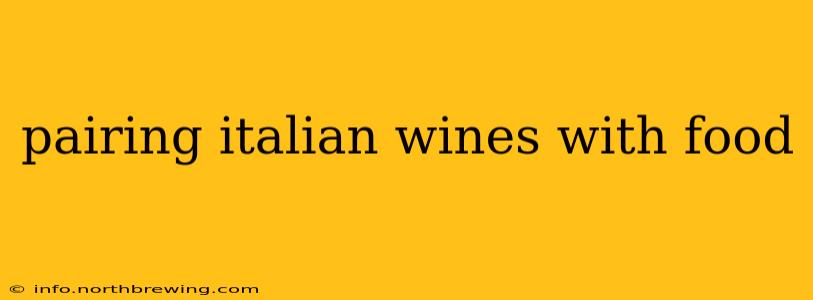Italy, a land of breathtaking landscapes and rich culinary traditions, boasts an equally diverse and impressive wine repertoire. Pairing Italian wines with food is an art, a delightful dance between flavors and aromas that can elevate any dining experience. This guide explores the nuances of Italian wine pairings, offering insights and suggestions to help you navigate this exciting world.
What are the main types of Italian wine?
Italy produces a vast array of wines, categorized by region and grape variety. Some of the most prominent include:
- Chianti (Tuscany): Known for its bright acidity and cherry notes, Chianti pairs well with tomato-based dishes, grilled meats, and hard cheeses.
- Barolo (Piedmont): A powerful, age-worthy Nebbiolo-based wine, Barolo is best enjoyed with rich, hearty dishes like braised meats, wild mushrooms, and truffles.
- Brunello di Montalcino (Tuscany): Another Sangiovese-based wine, Brunello is characterized by its structure, elegance, and aging potential. It complements game meats, roasted vegetables, and aged cheeses.
- Prosecco (Veneto): This sparkling wine, made primarily from the Glera grape, is known for its refreshing acidity and fruity notes. It's a versatile choice for aperitifs, seafood, and light pasta dishes.
- Pinot Grigio (Northeastern Italy): A crisp, dry white wine with notes of citrus and pear, Pinot Grigio pairs well with seafood, salads, and light appetizers.
- Soave (Veneto): A dry white wine made from the Garganega grape, Soave offers delicate floral aromas and a refreshing minerality. It complements seafood, poultry, and vegetarian dishes.
What are some good food pairings for Italian wines?
The best pairings often depend on the wine's characteristics – its acidity, tannins, body, and fruitiness – and the dish's dominant flavors and textures. Here are some general guidelines:
Light-bodied red wines (e.g., Chianti, Dolcetto):
- Pair with: Tomato-based pasta dishes, pizza, grilled chicken or fish, and lighter meats. The wine's acidity cuts through the richness of the tomato sauce, while its fruitiness complements the savory notes of the dishes.
Medium-bodied red wines (e.g., Barbaresco, Montepulciano d'Abruzzo):
- Pair with: Roasted vegetables, grilled sausages, mushroom dishes, and pasta with meat sauces. The wine's structure and tannins stand up to the richness of these dishes without overpowering them.
Full-bodied red wines (e.g., Barolo, Brunello di Montalcino):
- Pair with: Hearty stews, game meats, hard cheeses (like Parmesan or Pecorino), and dishes with rich sauces. The wine's power and complexity complement the intensity of these flavors.
Light-bodied white wines (e.g., Pinot Grigio, Soave):
- Pair with: Seafood, salads, poultry, and light pasta dishes. The wine's crispness and acidity cleanse the palate and enhance the delicate flavors of these dishes.
Medium-bodied white wines (e.g., Vermentino, Fiano):
- Pair with: Pasta with creamy sauces, risotto, and lighter seafood dishes. The wine's richness and complexity can handle creamy sauces without being overpowered.
Sweet wines (e.g., Vin Santo, Moscato d'Asti):
- Pair with: Desserts, particularly those with fruit or nuts, biscotti, and strong cheeses. The sweetness of the wine complements the sweetness of the dessert, creating a balanced and harmonious experience.
How do tannins affect food pairings?
Tannins are compounds found in red wine that create a drying sensation in the mouth. They can be a positive or negative element depending on the food. Tannins pair well with dishes high in fat or protein, as the fat binds to the tannins, softening their astringency.
What are some common mistakes to avoid when pairing Italian wine with food?
- Overpowering delicate flavors: A full-bodied red wine paired with a delicate fish dish will overwhelm the fish's subtle flavors.
- Clashing flavors: Pairing a highly acidic wine with a similarly acidic dish can create an unpleasant taste.
- Ignoring the wine's structure: A light-bodied wine won't stand up to a rich, flavorful dish.
What is the best way to learn more about Italian wine pairings?
The best way to expand your knowledge is through exploration and experimentation. Visit Italian restaurants, try different wines with various dishes, and read wine books and articles. Don't be afraid to experiment and find pairings you enjoy. Your palate is the ultimate guide!
This guide serves as a starting point for your Italian wine and food pairing journey. Enjoy the exploration, savor the flavors, and discover your perfect combinations. Cin cin!
